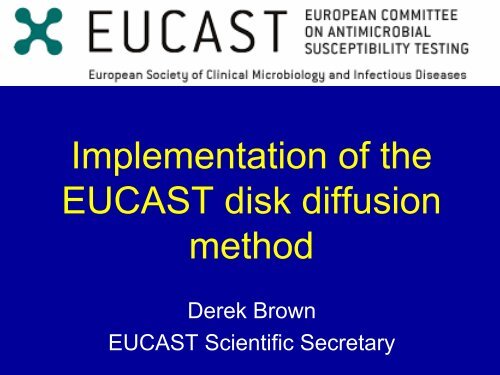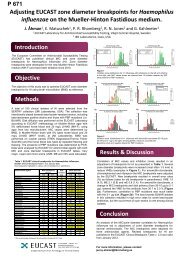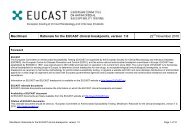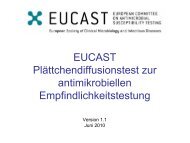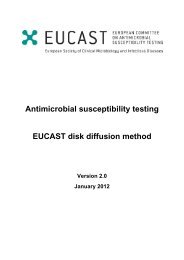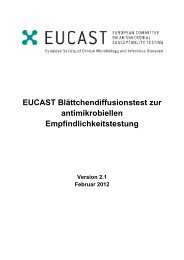Implementation of the EUCAST disk-diffusion method
Implementation of the EUCAST disk-diffusion method
Implementation of the EUCAST disk-diffusion method
- No tags were found...
You also want an ePaper? Increase the reach of your titles
YUMPU automatically turns print PDFs into web optimized ePapers that Google loves.
<strong>Implementation</strong> <strong>of</strong> <strong>the</strong><strong>EUCAST</strong> <strong>disk</strong> <strong>diffusion</strong><strong>method</strong>Derek Brown<strong>EUCAST</strong> Scientific Secretary
<strong>EUCAST</strong> <strong>disk</strong> <strong>diffusion</strong> <strong>method</strong>• Why develop a <strong>EUCAST</strong> <strong>disk</strong> <strong>diffusion</strong> test?• Development <strong>of</strong> <strong>the</strong> <strong>method</strong>• Calibration <strong>of</strong> <strong>the</strong> <strong>method</strong>• <strong>Implementation</strong> in individual laboratories
<strong>EUCAST</strong> early 2007• No plans for <strong>EUCAST</strong> <strong>disk</strong> <strong>diffusion</strong> test• MICs can be interpreted with <strong>EUCAST</strong> breakpoints• Automated systems can be calibrated to <strong>EUCAST</strong>breakpoints• Disk <strong>diffusion</strong> <strong>method</strong>s calibrated to <strong>EUCAST</strong>breakpoints are available in France, Sweden and<strong>the</strong> UK.......little enthusiasm for a new “<strong>EUCAST</strong> <strong>disk</strong><strong>diffusion</strong> <strong>method</strong>”
<strong>EUCAST</strong> consultation andquestionnaire 2007-8• France and UK likely to maintain <strong>the</strong>ir national<strong>method</strong>s, calibrated to <strong>EUCAST</strong> breakpoints, for<strong>the</strong> immediate future.• O<strong>the</strong>r countries were not keen to take on o<strong>the</strong>rnational <strong>method</strong>s with unfamiliar technique.• Most countries were currently using Kirby-Bauertype <strong>method</strong>s (particularly “CLSI”) and, if <strong>the</strong>yadopted <strong>EUCAST</strong> breakpoints, would prefer toretain <strong>the</strong> same <strong>method</strong>ology calibrated to<strong>EUCAST</strong> breakpoints (.....but get rid <strong>of</strong> HTM)
Benefits <strong>of</strong> a <strong>EUCAST</strong> <strong>disk</strong><strong>diffusion</strong> <strong>method</strong> (based on <strong>the</strong>Kirby-Bauer approach)• Identified as <strong>EUCAST</strong> <strong>method</strong> calibrated to<strong>EUCAST</strong> MIC breakpoints• Wide base <strong>of</strong> expertise throughout Europe (andworldwide)• KB technique familiar to most laboratories incountries without <strong>the</strong>ir own <strong>method</strong>• Extensive database <strong>of</strong> MIC v Zone diametersavailable for KB <strong>method</strong>?
<strong>EUCAST</strong> decision to develop a<strong>disk</strong> <strong>diffusion</strong> <strong>method</strong> June 2008Based on KB approach– MH medium– MH-F for fastidious organisms– 0.5 MF inoculum– 16-20h incubation– Most <strong>disk</strong> contents same– Most control strains same– Calibrated to <strong>EUCAST</strong> MIC breakpoints
Mueller-Hinton-fastidious (MH-F)Mueller-Hinton agar + 5% defibrinated horse bloodand 20 mg/L β-NADS. pneumoniae ATCC 49619 H. influenzae NCTC 8468
<strong>EUCAST</strong> QC tablesTargets NOT in italics are from ISO and/or CLSI recommendations
Calibration <strong>of</strong> <strong>EUCAST</strong> <strong>disk</strong><strong>diffusion</strong> <strong>method</strong>• Existing distributions <strong>of</strong> MIC v zone diameterwith <strong>the</strong> same technique• New distributions <strong>of</strong> MIC v zone diameter• Zone diameter distributions for routine isolates• Targeting critical areas <strong>of</strong> <strong>the</strong> MIC and zonediameter distributions• Targeting specific resistances
=6435 1 2 2 1 4 1 3 3 1Figure 7: Ceftriaxonen=350y=18.9 - 0.49xr=0.95MIC v zone diameter for ceftriaxone with Enterobacteriaceae321 1 1 1 1 6 1 1161 1 4 2 1 2 1 181 1 2 1 1 2Ceftriaxone MIC (μg/ml)4210.50.253 311 124451321 10.1252 26371 10.061 1 7 11 12 4 3 3 1 10.0328 12 13 19 9 101
Zone diameter correlates
Development <strong>of</strong> <strong>EUCAST</strong> <strong>disk</strong><strong>diffusion</strong> <strong>method</strong>• Tentative breakpoints have been published for allagents with MIC breakpoints• Continuing validation through– Existing and new distributions <strong>of</strong> MIC v zone diameter– Targeting critical areas <strong>of</strong> MIC v zone diameterdistributions and specific resistances– Zone diameter distributions for routine isolates• Ongoing maintenance
<strong>Implementation</strong> – <strong>EUCAST</strong> action• Documentation– Method description– Breakpoints– QC limits• Education– Teaching material (slideshow)– Meetings– Practical workshops– Laboratory visits• The laboratory in Vaxjo is an ESCMID Collaborative Centre –<strong>the</strong> ESCMID Observership program could be used for visit.– Publications/website• Inform media, <strong>disk</strong>, zone reader manufacturers
<strong>Implementation</strong> at national level”National antimicrobial committees”• Strategy at national level for implementation <strong>of</strong>breakpoints and <strong>method</strong>s• Inform people <strong>of</strong> implications for <strong>the</strong>ir laboratory/country• Education through meetings, publications, websites,practical workshops• Liaison with media, <strong>disk</strong>, zone-reader manufacturers• Liaison and consultation with <strong>EUCAST</strong>.• Liaison with groups involved in AMR-surveillance• External Quality assessment• Staged introduction may be appropriate – eg. large labsfirst
<strong>Implementation</strong> at local levelBefore routine use• Ensure all stakeholders are informed <strong>of</strong> implications for<strong>the</strong>ir laboratory/hospital• Appoint a ”champion” to implement <strong>the</strong> <strong>method</strong>• Visit laboratories using <strong>the</strong> <strong>method</strong>• Plan well in advance– media, <strong>disk</strong>, supplies– templates, zone-reader setup– computing (breakpoints/QC ranges)– documentation• Train staff in advance – demonstrations, practicalexperience, ensure that QC requirements are met• Use contacts in o<strong>the</strong>r laboratories and at <strong>EUCAST</strong>directly or through NACs or national <strong>EUCAST</strong> GC rep
<strong>EUCAST</strong> contacts for <strong>the</strong> <strong>disk</strong>• Erika Matuschek<strong>diffusion</strong> <strong>method</strong>(Swedish External Reference Laboratory forAntimicrobial Susceptibility Testing; ”SERLAST”)erika.matuschek@ltkronoberg.se• Gunnar Kahlmeter(<strong>EUCAST</strong> and SERLAST)gunnar.kahlmeter@ltkronoberg.se• Derek Brown(<strong>EUCAST</strong>)derek.brown222@btinternet.com
<strong>Implementation</strong> at local levelDuring introduction• Ensure that adequate staffing is available – will takemore time at first• Ensure that senior staff are available to answerquestions and deal with problems• Use national contacts– National Antibiotic Committees– Use contacts in laboratories already using <strong>the</strong> <strong>method</strong>• Use <strong>EUCAST</strong> contacts
<strong>Implementation</strong> at local levelAfter implementation• Keep <strong>the</strong> <strong>method</strong> up-to-date• Continue to educate staff• Report problems to <strong>EUCAST</strong>– Erika Matuschek (SERLAST)• Be prepared to help o<strong>the</strong>r laboratories
Acknowledgements• Gunnar Kahlmeter• Erika Matuschek and Jenny Åhman• <strong>EUCAST</strong> Steering Committee• National Committees• Collaborating laboratories• Individual experts


